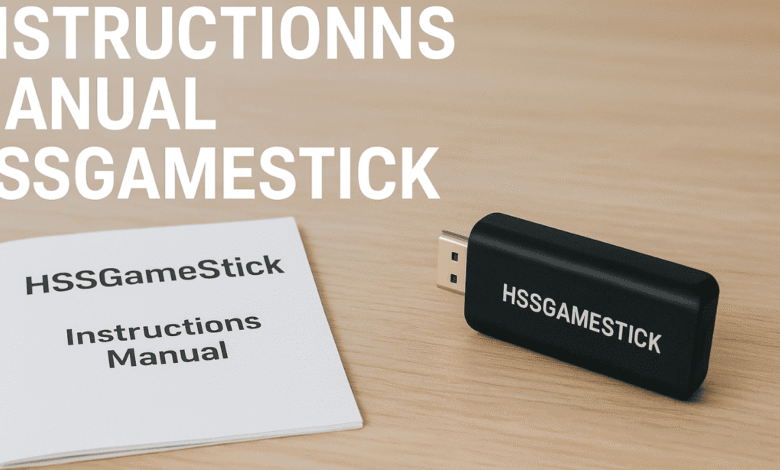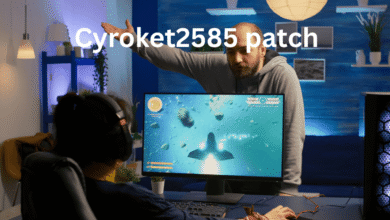instructions manual hssgamestick: Complete Setup, Tuning, Troubleshooting and Firmware Guide

If you own an HSSGameStick or are thinking about getting one, the instructions manual hssgamestick is the single most useful document to get you from unboxing to smooth play. It explains essential setup steps, how to tune display and controller options, and the safe way to update firmware. Reading the instructions manual hssgamestick saves time and prevents avoidable mistakes that often cause frustration.
Unboxing and hardware setup explained
Before you power anything on, follow the sequence in the instructions manual hssgamestick to ensure a smooth setup.
What to expect in the box
- The console stick unit
- Power cable (USB) and adapter
- HDMI extender or short cable
- A wireless or wired controller (depending on package)
- Quick start leaflet and warranty card
First-time connection — step-by-step
- Power off your TV and locate an available HDMI port.
- Insert the console stick into the HDMI port or HDMI extender.
- Connect the USB power cable to a USB power adapter or to a powered USB port on the TV.
- Turn on the TV, select the HDMI input, and follow the on-screen prompts from the instructions manual hssgamestick.
- Pair the controller via the pairing button or by following the manual’s Bluetooth instructions.
These basic steps are simple, but the instructions manual hssgamestick emphasizes correct power sourcing and pairing sequence to avoid connectivity issues.
Display and performance settings you should know
Getting the best image and performance depends on a few key settings. The instructions manual hssgamestick walks through these options so you can tailor visuals for your TV and games.
Key display options
- Resolution selection (720p, 1080p, or auto)
- Aspect ratio and overscan correction
- Frame-rate preferences and refresh rate matching
- Brightness, contrast and gamma adjustments
Performance tweaks
- Power-saving modes vs. performance mode
- Frame limiters and vsync options for smoother play
- Shaders or filter toggles in emulators to replicate retro looks
Follow the recommendations in the instructions manual hssgamestick for common TV types. If you have older hardware, the manual’s suggested resolution and overscan settings will prevent cropped screens and ensure crisp visuals.
Controller customization and input optimization
One of the most powerful sections of the instructions manual hssgamestick covers controller settings. Small tweaks here can greatly improve responsiveness and enjoyment.
Button mapping and analog tuning
- Remap buttons to suit fighting games, platformers, or racing titles.
- Adjust analog stick sensitivity and deadzone to eliminate drift or sluggish response.
- Configure vibration intensity or turn it off for longer battery life.
Quick controller tips:
- Create separate controller profiles for different genres.
- Reduce deadzone for precision shooters; increase it for platformers to avoid accidental movement.
- Keep a backup of your preferred controller profile in case you reset the device.
The instructions manual hssgamestick outlines these adjustments with practical examples and recommended starting values.
Emulator tweaks for retro gaming
If you enjoy classic games, the instructions manual hssgamestick dedicates a section to emulator-specific settings. These settings let you balance authenticity with performance.
Common emulator controls
- Save-state and load-state management
- Audio latency and sample rate tweaks to reduce pops and delays
- Graphics filters and integer scaling for pixel-perfect rendering
- Frame skip and speed hacks to address heavy ROMs
Practical points to apply:
- Use integer scaling for pixel-perfect retro look on modern displays.
- Keep periodic save-states when experimenting with advanced emulator options.
- Test audio latency after changing sample rates to ensure lip-sync and soundboard effects remain accurate.
Firmware updates and troubleshooting
Keeping the system firmware current unlocks new features and fixes bugs. The instructions manual hssgamestick describes how to update safely and how to recover if something goes wrong.
Safe firmware update checklist
- Back up all save files and controller profiles before starting.
- Use a FAT32-formatted USB or microSD as required by the device.
- Confirm you have the correct firmware file and follow the folder structure the manual specifies.
- Avoid power interruption during the update process.
Troubleshooting common problems
- Black screen: try alternate HDMI ports, check power supply, and confirm TV input.
- Controller not pairing: replace batteries, re-pair following manual steps, or reset the controller.
- Lag or stuttering: reduce resolution or enable performance mode per the instructions manual hssgamestick.
- Failed update: follow the recovery steps in the manual to perform a safe restore or re-flash.
These troubleshooting tips mirror the structured guidance found in the instructions manual hssgamestick and are designed to be easy to follow under stress.
Backup, profiles, and save management
Protecting your progress and configuration avoids headaches. The instructions manual hssgamestick recommends a routine backup strategy.
- Regularly export controller profiles after fine-tuning.
- Copy save files to external storage before firmware operations.
- Keep a dated archive of important configurations so you can roll back when needed.
A simple habit of backing up saves and profiles will prevent permanent loss and makes it easy to migrate to a replacement unit.
Advanced tips and best practices
For users who want to squeeze the most from their system, the instructions manual hssgamestick offers advanced guidance that remains accessible.
- Create game-specific profiles that automatically load per title.
- Use wired networking when possible for online features to reduce input latency.
- Limit background services to preserve system resources during demanding sessions.
- Document your preferred settings so you can replicate them on other units or share with friends.
Small, disciplined routines based on the manual’s recommendations lead to consistently better performance and fewer surprises.
Quick reference checklist (handy points)
- Read the startup and safety section first in the instructions manual hssgamestick.
- Verify power source and USB current rating before connecting.
- Pair and test controller response in the menu before starting a game.
- Back up profiles and saves before firmware updates.
- Keep the firmware and emulator versions up to date following manual steps.
Conclusion — putting the instructions manual hssgamestick to work
A well-written instructions manual hssgamestick is more than paperwork: it’s a roadmap to better gaming. From unboxing and correct hardware setup to display tuning, controller customization, emulator tweaks, firmware updates, and backups, the manual provides an organized path for both new and experienced users. Follow the sections step by step, keep regular backups, and apply the quick tips to get the most reliable and enjoyable experience from your device. With these practical steps drawn from the manual, you’ll be ready to play smarter and troubleshoot faster whenever an issue arises.
FAQs on instructions manual hssgamestick
Q1. What is the instructions manual hssgamestick?
The instructions manual hssgamestick is the official guide that explains how to set up, configure, and maintain the HSSGameStick console. It covers hardware connection, controller pairing, display tuning, emulator settings, firmware updates, and troubleshooting tips.
Q2. How do I set up my HSSGameStick for the first time?
Follow the steps in the instructions manual hssgamestick: connect the stick to your TV’s HDMI port, power it through USB, select the correct HDMI input on your TV, and pair your controller using the pairing button or Bluetooth instructions.
Q3. Can I customize the controller settings?
Yes. The instructions manual hssgamestick provides guidance on button remapping, analog stick sensitivity adjustments, deadzone control, and vibration settings to suit different game genres.
Q4. How can I improve the display quality on my HSSGameStick?
You can adjust resolution, aspect ratio, brightness, and contrast in the settings menu. The instructions manual hssgamestick suggests specific configurations based on TV type and performance preferences.
Q5. What should I do if my controller is not connecting?
Check the battery, ensure the controller is in pairing mode, and follow the pairing steps in the instructions manual hssgamestick. If issues persist, try resetting the controller and re-pairing.



